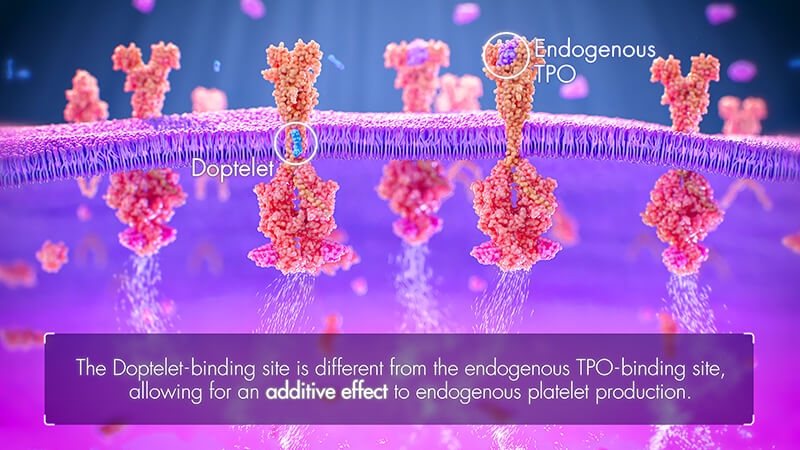

DOPTELET NOW HAS PARITY ACCESS WITH ELTROMBOPAG AT SOME OF THE LARGEST COMMERCIAL PLANS4
Use our look-up tool to see if your commercial plan is eligible for Doptelet.
Doptelet acts fast and lasts1,5§
In the 6-month core study1:
Lift platelet counts quickly
8 DAYS
In as few as 8 days, 66%
of Doptelet patients reached
50,000/μL (secondary endpoint).
Raise and maintain platelet counts
50,000
With Doptelet, patients achieved
platelet goals of 50,000/μL
(primary endpoint).
Keep platelet counts lifted
12.4 WEEKS
Patients on Doptelet reached target platelet
counts of 50,000/μL for a median of 12.4
cumulative weeks (primary endpoint).‡§
In the pivotal trial and open-label extension6:
Reach target levels
94% of patients reached 50,000 platelets/μL at least once in Doptelet clinical trials.II
The study was not placebo-controlled; therefore, causality cannot be attributed, and hypothesis testing cannot determine whether within-arm changes were due to drug effect. The extension study may not meet the FDA definition of an adequate and well-controlled study due to its study design.
In the post hoc analysis of the core and extension phase7:
Response was maintained
83% of the time patient platelet response was maintained while on treatment during the core and extension phases.
Post hoc analyses should be interpreted with caution, and results from these analyses may differ from those observed in clinical practice. The post hoc analysis is not included in the Doptelet Prescribing Information and the FDA did not consider this analysis in approving Doptelet.
Core Study: Efficacy was evaluated in a 6-month, multicenter, randomized, double-blind, placebo-controlled Phase 3 study. Patients had received one or more prior chronic ITP therapies and had average screening and baseline platelet counts of <30×109/L. Forty-nine patients were randomized (2:1) to receive either Doptelet (n=32) or placebo (n=17).1
- The primary efficacy endpoint was the cumulative number of weeks of platelet response, defined as a platelet count ≥50×109/L in the absence of rescue therapy, over 6 months of once-daily treatment in adults with chronic ITP. Doptelet-treated patients had a median duration of 12.4 cumulative weeks vs 0 weeks for placebo1
- A secondary efficacy endpoint was the proportion of patients with a platelet response (platelet counts ≥50×109/L) at Day 8. 66% (n=21/32) of Doptelet-treated patients had platelet counts of ≥50,000/μL at Day 8 compared to placebo (n=0/17)1
Open-label extension: Patients could enter the open-label extension phase if they completed the 6-month core study, or if they experienced a lack of efficacy during that period. In the extension phase, all patients received titrated Doptelet once daily. Thirty-nine patients (24 Doptelet and 15 placebo) entered the 90-week maintenance period of the extension phase, in which Doptelet dose titration and downward titration of concomitant ITP medications were allowed. At the end of the extension phase, a 4-week, dose-tapering period was followed by a 30-day follow-up after the last dose of Doptelet.5,8
- The primary endpoint of the extension study was to assess the long-term safety and efficacy of treatment with Doptelet by measuring platelet response rate, bleeding, and the use of rescue therapy5
- Exploratory endpoints included the percentage of patients who achieved platelet counts ≥50,000/μL or ≥100,000/μL at any time during the core study and its extension phase. These endpoints were reported in an integrated analysis of the Phase 3 core study and extension phase data. In an integrated analysis of the core study and its extension phase, 93.8% of patients initially randomized to Doptelet and who continued to be treated with Doptelet during the extension phase achieved a platelet count of ≥50,000/μL at any time, compared to 64.7% of placebo patients who rolled over to Doptelet.6,8
Compliance comes with convenience
When selecting treatment for ITP, ASH guidelines recommend the consideration of patient preferences and their potential impact on adherence9
No food-type restrictions
Patients can take Doptelet with any food (food required); no administration concerns with minerals like calcium or magnesium.1
No liver monitoring
Doptelet does not require additional liver-function monitoring; no significant hepatotoxicity seen in Doptelet clinical trials.1,5
No treatment injections
Doptelet can be taken anytime, anywhere,
without adding trips to the doctor
(platelet monitoring required).1‡
*Doptelet-treated patients achieved a platelet count of 50x109/L for a median of 12.4 cumulative weeks. 66% of Doptelet-treated patients were able to achieve a platelet count of 50x109/L in as few as 8 days.1
†Food required.1
‡Platelet monitoring required. After initiating therapy with Doptelet, assess platelet counts weekly until a stable platelet count of ≥50x109/L has been achieved, and then obtain platelet counts monthly thereafter.1
§Throughout the core study and extension phase, 72.3% of patients were exposed to avatrombopag for at least 32 weeks. In the open-label extension phase for those patients continuing Doptelet treatment, a response was achieved at 44.2% of visits.5,8
IIIn an integrated analysis of the core study and its open-label extension phase, 93.8% of patients initially randomized to Doptelet achieved a platelet count of ≥50,000/μL at any time, and 64.7% of placebo patients who rolled over to Doptelet in the open-label extension phase also reached this metric.6
¶Avatrombopag was not studied as part of the 2019 ASH guidelines.9
Hear About a Patient's Experience on Doptelet
Dop-TELL-It Like It Is: Doptelet Patient Experience
To see more videos on Doptelet, visit our video library.

Mechanism of action
Doptelet works to address the underlying pathophysiology of chronic ITP by increasing platelet production1
Doptelet is an oral thrombopoietin receptor agonist (TPO-RA) that works to stimulate platelet production in individuals with chronic ITP1
Thrombopoietin (TPO) is a hormone produced in the liver that acts by binding to hematopoietic stem cell receptors in the bone marrow1,10,11
When bound to these cell receptors, TPO activates the JAK-STAT signaling pathway, resulting in stem cell differentiation to megakaryocytes, leading to the production of platelets10,11
Doptelet acts by binding to the same receptors as the endogenous TPO, albeit at a different binding site, ultimately activating the JAK-STAT pathway, which increases platelet production10,11
Doptelet does not block native TPO; it allows for an additive effect to endogenous platelet production1

Find out more about the recommended use of TPO-RAs
The American Society of Hematology (ASH) guidelines recommend the use of TPO-RAs as a second-line therapy9¶
The updated International Primary ITP Consensus Report recommends the use of TPO-RAs as a therapy subsequent to initial therapy12
TPO-RA=thrombopoietin receptor agonist.
Any questions?
Our support specialists can help answer your questions about Doptelet and access options — call us at
855-4LIFTUP (855-454-3887)
Monday–Friday 8 AM–8 PM ET.

Read about Doptelet efficacy
Doptelet worked to raise platelet counts in patients with ITP in the Phase 3 clinical study. Ready to see the numbers?1†
- DOPTELET (avatrombopag) [prescribing information]. Durham, NC: AkaRx, Inc; 2021.
- Nplate (romiplostim) [prescribing information]. Thousand Oaks, CA: Amgen; 2022.
- Promacta (eltrombopag) [prescribing information]. East Hanover, NJ: Novartis Pharmaceuticals Corp; 2021.
- Data on File. H2H National Data. 2023: Sobi, Inc.
- Jurczak W, Chojnowski K, Mayer J, et al. Phase 3 randomised study of avatrombopag, a novel thrombopoietin receptor agonist for the treatment of chronic immune thrombocytopenia. Br J Haematol. 2018;183(3):479-490.
- Nagalla S, Vredenburg M, Tian W, Allen LF. Platelet response to avatrombopag in patients with chronic immune thrombocytopenia: additional analyses from a phase 3 study and its extension. Blood. 2019;134(suppl 1):1071.
- Jain S, Gernsheimer T, Kolodny S, Bernheisel C, Vredenburg M, Panch SR. Additional efficacy analysis of avatrombopag phase III data for the treatment of adults with immune thrombocytopenia. Platelets. 2023 Dec;34(1):2195016.
- Al-Samkari H, Aggarwal K, Vredenburg M, Tian W, Allen LF. Long-term response rates in patients with chronic immune thrombocytopenia treated with avatrombopag: additional analyses from a phase 3 study and its extension phase. Blood. 2019;134(suppl 1):2356.
- Neunert C, Terrell DR, Arnold DM, et al. American Society of Hematology 2019 guidelines for immune thrombocytopenia. Blood Adv. 2019;3(23):3829-3866.
- Kuter DJ. The structure, function, and clinical use of the thrombopoietin receptor agonist avatrombopag. Blood Rev. 2022;53:100909.
- Zufferey A, Kapur R, Semple JW. Pathogenesis and Therapeutic Mechanisms in Immune Thrombocytopenia (ITP). J Clin Med. 2017 Feb 9;6(2):16.
- Provan D, Arnold DM, Bussel JB, et al. Updated international consensus report on the investigation and management of primary immune thrombocytopenia. Blood Adv. 2019;3(22):3780-3817.